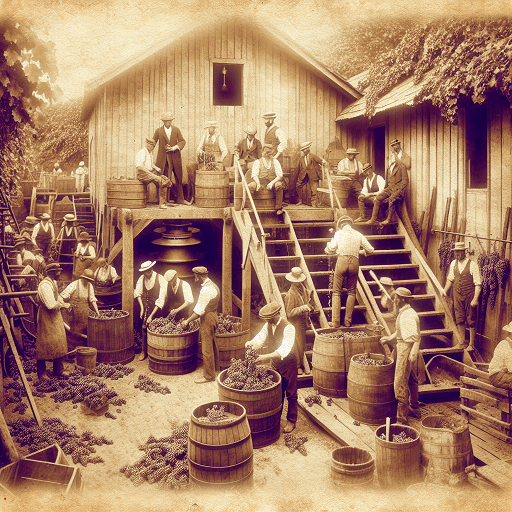Did you know that Champagne was discovered by accident? This sparkling wine has a rich history dating back to the 17th century. Uncover the fascinating story behind this celebratory drink.
Champagne, the quintessential celebratory drink, has a history as effervescent as its bubbles. This iconic sparkling wine, produced exclusively in the Champagne region of France, has been a symbol of luxury, celebration, and sophistication for centuries. In this article, we delve into the fascinating history of Champagne, exploring its origins, development, and the personalities that have shaped its journey. Additionally, we will highlight two exquisite Champagnes from Great Wines Direct, providing links to these products for those keen to experience the magic of Champagne firsthand.
Origins of Champagne
The story of Champagne begins in the vineyards of the Champagne region in northeastern France. The region's unique climate and chalky soils create the perfect conditions for growing the grapes used in Champagne production—primarily Chardonnay, Pinot Noir, and Pinot Meunier. However, Champagne as we know it today didn't exist until the late 17th century. Before this time, the wines of Champagne were still wines (non-sparkling) and often red.
The Accidental Sparkle
The transformation of Champagne into a sparkling wine is often credited to the Benedictine monk Dom Pierre Pérignon. Contrary to popular belief, Dom Pérignon did not invent Champagne but significantly improved its production methods. Working at the Abbey of Hautvillers, he experimented with blending different grape varieties and refining the winemaking process. Though he aimed to eliminate the bubbles that formed naturally during fermentation, his efforts inadvertently laid the groundwork for the sparkling wine we cherish today.
The Birth of Modern Champagne
The early 18th century saw the emergence of the méthode champenoise (traditional method), which involves a second fermentation in the bottle to create the bubbles. This method, combined with the use of stronger glass bottles and corks, allowed winemakers to control the effervescence and quality of Champagne. The méthode champenoise remains the gold standard for Champagne production to this day.
Champagne Becomes a Symbol of Luxury
By the 19th century, Champagne had firmly established itself as a symbol of luxury and celebration. The region's producers, including notable houses like Moët & Chandon, Veuve Clicquot, and Louis Roederer, began to market Champagne as a drink for the elite. Royal courts and aristocrats across Europe embraced Champagne, further cementing its status. The invention of the wire cage (muselet) to secure the cork in place also contributed to Champagne's growing popularity by preventing accidental openings and explosions.
Champagne in the Modern Era
The 20th century brought significant advancements to Champagne production and marketing. Technological innovations improved the consistency and quality of Champagne, while the rise of global trade expanded its reach. Today, Champagne is enjoyed worldwide and remains a staple at celebrations, from weddings to New Year’s Eve parties.
Highlighting Two Exceptional Champagnes
For those looking to indulge in the rich history and exquisite taste of Champagne, Great Wines Direct offers a superb selection. Here are two remarkable Champagnes available on their website:
-
Pol Roger Brut Reserve NV Champagne
- Description: Pol Roger Brut Reserve is a perfect blend of the three traditional grape varieties: Pinot Noir, Pinot Meunier, and Chardonnay. Known for its elegance and finesse, this Champagne offers a harmonious balance of ripe fruit flavours, floral notes, and a hint of brioche.
- Tasting Notes: Fresh and fruity on the palate, with a long, crisp finish.
-
Link: Pol Roger Brut Reserve NV Champagne
-
Bollinger Special Cuvée Brut NV Champagne
- Description: Bollinger Special Cuvée is a classic non-vintage Champagne that showcases the house’s expertise in creating rich, full-bodied sparkling wines. It is predominantly made from Pinot Noir, giving it a robust structure and depth of flavour.
- Tasting Notes: Notes of apple, pear, and brioche, with a creamy texture and a long, elegant finish.
- Link: Bollinger Special Cuvée Brut NV Champagne
The Future of Champagne
As we look to the future, the Champagne industry continues to innovate while honouring its storied past. Sustainability and climate change are at the forefront of modern winemaking practices, with many Champagne houses adopting eco-friendly methods to preserve the region's unique terroir. Additionally, the growing popularity of rosé Champagne and low-dosage (lower sugar) options reflects evolving consumer preferences.
Conclusion
The history of Champagne is a testament to the ingenuity and passion of its producers. From its accidental beginnings to its status as a global symbol of celebration, Champagne has captivated the hearts and palates of wine lovers for centuries. Today, it continues to embody luxury, elegance, and the joy of shared moments.
Whether you're toasting a special occasion or simply enjoying a glass with friends, the sparkle of Champagne adds a touch of magic to any experience. Explore the rich heritage and exquisite flavours of Champagne by trying some of the exceptional bottles available at Great Wines Direct, such as the Pol Roger Brut Reserve NV Champagne and the Bollinger Special Cuvée Brut NV Champagne. Raise your glass and celebrate the timeless allure of Champagne!

